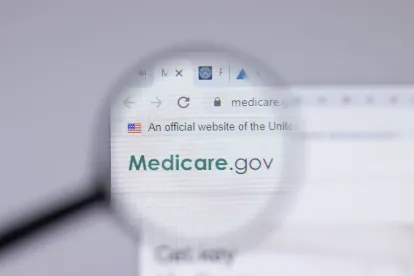On September 1, 2023, the Centers for Medicare and Medicaid Services (CMS) issued a long-awaited proposal to establish new federal minimum staffing standards for long-term care facilities.[1] If the proposed rule is finalized, CMS estimates that approximately 75% of all nursing homes would have to “strengthen staffing in their facilities” in order to meet the new requirements.[2]
Proposed Minimum Staffing Requirements
As proposed, nursing homes will be required to provide:
A Registered Nurse (RN) on-site 24 hours per day, 7 days per week (the “24/7 RN Requirement”);
At least .55 RN hours per resident per day (the “.55 RN HPRD”); and
At least 2.45 Nurse Aide (NA) HPRD (the “2.45 NA HPRD”).
CMS seeks public comment on whether a minimum total nurse staffing standard, such as 3.48 HPRD among other alternatives, should also be required either in place of – or in addition to – a requirement only for RNs and NAs.
As proposed, the RN and NA HPRD requirements would establish a floor that is independent of a facility’s patient case-mix. In other words, no facility would be permitted to operate below .55 RN HPRD and 2.45 NA HPRD, and if the acuity needs of residents in a facility require a higher level of care, a higher RN and NA staffing level would be required.
In order to give facilities sufficient time to hire additional staff, CMS has proposed a staggered implementation of the minimum staffing standards:
The 24/7 RN Requirement would be implemented two years after publication of a final rule; and
The .55 RN HPRD and 2.45 NA HPRD requirements would be implemented three years after publication of a final rule.
For rural facilities, these implementation dates would be further extended, to three years for the 24/7 RN Requirement, and five years for the .55 NA HPRD and 2.45 RN HPRD requirements.
Hardship Exemptions
The proposed rule includes a provision to allow for a temporary hardship exemption from the minimum staffing standards, if a facility can demonstrate the following:
Workforce unavailability based on location, as evidenced by (i) either a medium (i.e., 20 percent below the national average) or low (i.e., 40 percent below national average) provider-to-population ratio for the nursing workforce, as calculated by CMS, by using the Bureau of Labor Statistics and Census Bureau data, or (ii) the facility’s location at least 20 miles away from another LTC facility (as determined by CMS); and
Good faith efforts to hire and retain staff through the development and implementation of a recruitment and retention plan by documenting job postings and job vacancies, including the number and duration of vacancies, job offers made, and competitive wage offerings; and
A financial commitment to staffing by documenting the total annual amount spent on direct care staff.
Any facility that CMS identifies as a special focus facility, or as having widespread or a pattern of insufficient staffing (within the preceding 12 months) resulting in a citation of actual resident harm or immediate jeopardy, will not be eligible for the hardship exemption. Facilities that fail to submit required data to CMS’s Payroll-Based Journal System will also be ineligible for a hardship exemption. The proposed rule notes that facility compliance with staffing requirements will be published on the Care Compare website, including whether a facility has obtained a hardship exemption.
Facility Assessments
The proposed rule also includes updates and clarifications to the existing facility assessment requirements. Among other changes, nursing homes would be required to use the facility assessment to: (i) assess the specific needs for each resident unit in the facility; (ii) consider the specific staffing needs for each shift (e.g., day, evening, night, and weekends); (iii) develop and maintain a staffing plan to maximize recruitment and retention of nursing staff; and (iv) incorporate the input of facility staff and their representatives into their facility assessment.
Public Comment Period
Stakeholders may submit comments on the proposed rules during the 60-day comment period that ends on November 6, 2023. CMS specifically requested comments on several proposals, including:
The feasibility of each facility having an RN on site 24 hours a day, seven days a week, including possible alternatives.
Whether in addition to, or in place of, the .55 RN HPRD and 2.45 NA HPRD requirements, a total nurse staffing standard should be required.
The most appropriate approach to display determinations of facility compliance with minimum staffing standards on the Care Compare website.
The benefits and tradeoffs of the different standards, evidence, or methodologies that states use to establish minimum staffing standards and other key considerations.
CMS’ decision to propose minimum staffing standards is certain to be a hot topic in the industry as facilities continue to struggle with a labor crisis, and may have unintended consequences that were noted by CMS itself in 2016, when it stated: “We continue to be concerned that a mandated ratio could result in unintended consequences, such as staffing to the minimum, input substitution (hiring for one position by eliminating another), and task diversion (assigning non-standard tasks to a position), as well as stifling innovation . . .”[3] Nursing homes and other stakeholders are encouraged to submit comments to CMS as they begin preparing for a new era of staffing mandates.
FOOTNOTES
The proposed rule can be found in today’s Federal Register.
See CMS Press Release at: https://www.cms.gov/newsroom/press-releases/hhs-proposes-minimum-staffing-standards-enhance-safety-and-quality-nursing-homes.
See Federal Register, Vol. 81, No. 192 at p. 68754 (October 4, 2016).





 />i
/>i

